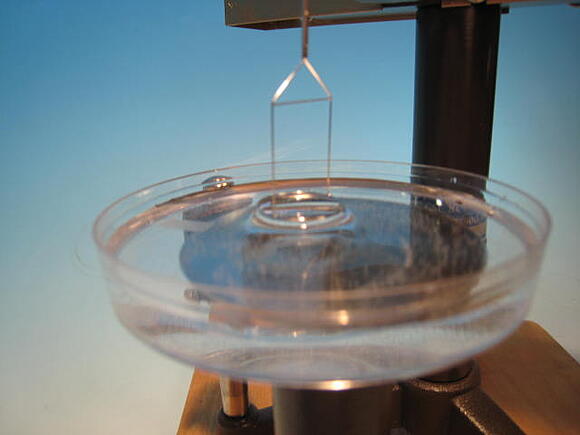I was musing, the other day on the designs of two ring tensiometers. One of them is called an interfacial tensiometer and the other simply a tensiometer. The plain tensiometer works only with an upward pull and the interfacial works with both an upward pull as well as a downward push. Before I get to my question a couple of definition might be useful.
The phenomenon called surface tension is the property at the surface of a liquid that causes it to behave like a plastic sheet. When you see an insect walking on the surface of a pool or pond, it is because of the surface tension of the water.
Temperature Sensitive
The normal example is the surface tension of water exposed to air. At room temperature the surface tension of water is a force around 70 dynes/ per centimeter. At the freezing point of water the surface tension is close to infinite. At the other end of the spectrum; as the temperature approaches boiling, the surface tension of the water moves toward 0.
Measurement Using a Ring
One of the ways to measure surface tension of a liquid is to use a platinum ring. This ring is pulled through the surface. The liquid adheres to the ring for some distance above the surface. When it breaks away the force is measured and converted to surface tension.

Interfacial Tension Between Two Liquids
The physics and or chemistry that produces surface tension also creates a clear interface between two non-miscible liquids (liquids that do not mix). The strength of this plastic like sheet between the liquids is called interfacial tension. Another way of relating to this is to define interfacial tension as the force that keeps the surface of one liquid from invading the surface of another liquid.
Measuring Interfacial Tension
To measure interfacial surface tension, for example the interfacial tension of water and oil, a platinum ring is pulled through the surface of the water into the oil. The water adheres to the ring for some distance above the surface. When it breaks away the force is measured and converted to interfacial surface tension.
In old literature there is a paper describing “An Interfacial Tensiometer For Universal Use”. This paper defined the need for both the upward pull (water to oil) and the downward push (oil to water).
I waded through a mound of interfacial tension material to find the application or circumstances in which a downward movement, as from oil to the water, was important. I found nothing.
Do You Need Downward Measurement?
I would very much like to know if the downward measurement has application and to know the significance of the difference between upward interfacial tension and downward interfacial tension.
Please let me know if you have anything on this. Either comment on this post or email me at artgatenby@gmail.com
Art
Want to Subscribe?
P.S. Did you know that you can subscribe to these exposés, rants, raves and ramblings? All you have to do is insert your email address into the box just to the right of the title.


